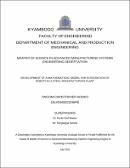| dc.description.abstract | The use of computer-controlled robots is increasingly picking up in today’s manufacturing industries. Industrial robot application in manufacturing industries allows for improved flexibility and configurability required for providing product variability. However, in technologically low developed countries, steel manufacturing tasks in steel industries are mainly executed manually. Due to the demand for improved product quality, productivity, safety, and reduction in manufacturing costs, there is a need for these plants to integrate robots into the operations. Two automated steel manufacturing Plants A and B, consisting of three manufacturing cells were considered during the research. The aim was to study the material handling systems used in each manufacturing cell, the material storage systems, steel manufacturing processes, the adaptability of each manufacturing cell to new technologies, and the current steel manufacturing technologies to identify manufacturing tasks suitable for robot integration. A systematic robotic integration process in steel manufacturing industries by utilizing a Markov decision model was developed.
A finite-state Markov decision process model for robot automation decision was formulated while considering specific tasks to be accomplished by a robot in a given manufacturing cell. The Markov chain formulated represented states of robot performance under automation policies. The material handling cost matrices represented the long-run measures of each manufacturing cell performance for the Markov decision process problem formulated. The aim was to determine an optimal robotic automation decision for each manufacturing cell to minimize the long-run material handling costs for the given state of performance. Computational efforts using the Markov decision process approach provided promising results for material handling cost minimization for both steel plants and the replacement of humans with robots at the zinc pot reduced the average waiting time and increased the line utilization rate. The overall steel processing time correspondingly decreased by about 63% compared to the existing manufacturing cell. Robot integration in both steel plants presented solutions for reducing labour costs, material-handling damage, improving the productivity of automated steel manufacturing systems, and overall safety of the steelworkers. However, it is desirable to extend the research to analyse the impact on the non-stationary performance of a robot on the decisions taken. There is a need to expand the model to consider automation options for minimum material handling costs in the context of Continuous-Time Markov Chains (CTMC). The assumptions made during the simulation study did not consider worker fatigue and machine breakdowns. The justification of the proposed model by considering worker fatigue and machine breakdowns is an area of further research in this field of study. | en_US |

